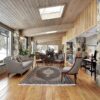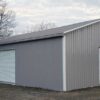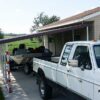Metal Buildings and Wildland Fires
Wildland fires are fearsome. People die and houses burn, reducing years of memories to nothing. Taking steps now to reduce the damage can saves lives, property and a way of life.
Metal buildings can be part of your defensive plans. Here is a look at how metal and wood react in a fire and the critical need for defensible space.
What Happens in a Wildfire
They can burn homes and homes. Wildfires are caused by weather conditions, but most are started by people. In fact, more than 90% of all wildfires are caused by humans.
Each year more than 70,000 such fires burn more than 7 million acres of wilderness land in the U.S. As more and more homeowners build in woodland areas, whether around forests, in rural spots or in the mountains, the number of homes lost increases.
From 2004 to 2014, over 15,000 primary structures, that is homes, were destroyed by wildfires.
Protecting Your Home
There are several ways you can increase the chances that your home will make it through and still be habitable.
Experts, like those at the California Department of Forestry and Fire Protection, recommend two lines of protection:
- Using defensible space around the outside of your home
- Hardening your home by using resistant building materials
Here is a closer look at each method.
Defensible Space
Creating defensible space means setting up a buffer area around your house and its outbuildings. This can effectively keep the fire far enough away to prevent damage.
This area, anywhere from 30’ to 100’, achieves three results:
- The wildfire is slowed down or can’t spread.
- Your home doesn’t catch fire, either directly from flying embers or from radiant heat.
- Firefighters are protected.
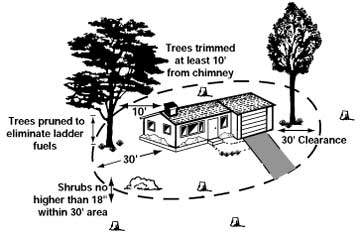 Zone 1: The first buffer zone spreads out 30’ to 50’ from your home, deck and other structures like garages and outbuildings. You need to get rid of dead foliage, dry leaves and pine needles. They collect not just in your yard but also in gutters and on the roof.
Zone 1: The first buffer zone spreads out 30’ to 50’ from your home, deck and other structures like garages and outbuildings. You need to get rid of dead foliage, dry leaves and pine needles. They collect not just in your yard but also in gutters and on the roof.
Trees need to be trimmed regularly. Branches should be at least 10’ from the house, chimney and other trees. Anything flammable needs to be moved away from the house. This means wood piles should be relocated to Zone 2. Plants and shrubs that might catch fire need to be taken out or pruned back.
Get rid of anything flammable under decks and around or under the house. Outdoor furniture, play equipment and woodpiles need to be moved away from trees and shrubs.
In Zone 2, which starts where Zone 1 ends, use vertical and horizontal spacing to prevent fire from spreading. How much depends on the slope of the land and the type and dimensions of the vegetation.
For vertical spacing, make sure branches are 6’ or more off the ground. If shrubs grow under trees, keep the clear space at least three times the size of the shrub. If you shrub is 3’ high, there should be 9’ from the top of it to the bottom branch of the tree it is under.
Horizontal spacing also depends on the slope. For example, in flat areas, keep twice the amount of space between shrubs as they are high. For example, if it is 2’ high, keep 4’ between shrubs. If those same shrubs are on a fairly steep incline, increase the space to six times the height.
Hardening Your Home
Fire embers during a wildfire are responsible for much of the damage that occurs to property. They can fly up to a mile, landing on roofs and setting the structure alight.
Experts can make a wood home more fire resistant with the use of materials that make it less likely to catch fire. For a roof, that would mean using tile instead of shingles or wood shakes. Or replace it with a metal roof.
Walls made of board, shingles or panels are easily set on fire. Experts recommend ignition resistant building materials like stucco, cement or fire-treated wood. These materials need to be used on the entire exterior, from the roof down to the foundation, in order to make them effective.
Other recommendations for hardening your home are available from your local fire department.
The Value of Building with Metal
The fact that metal roofing material is recommended as a way to make a roof fire resistant shows that it is an effective material for protecting your home during a wildfire.
Tests done by a metal roofing manufacturer achieved a one-hour fire rating. The panels used on the roof are the same that are used on the exterior of the house when you construct a metal building.
That means it is likely that it will provide a real measure of protection against the two ways wildland fires destroy homes. First, the metal will help resist flying embers. Second, it will protect the interior from the fire dangers of radiant heat.
In addition, metal provides almost nothing in the way of fuel to feed the fire, unlike wood which is highly combustible. Many homeowners feel that an entire home made of metal can help reduce the chances of damage during a wildland fire.
Studies About Fire and Metal Buildings
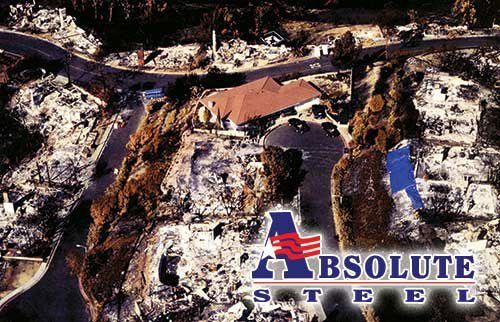
We recently obtained an untouched overhead image of the 1973 Laguna, California fire in a residential area. Every single home in the area was destroyed, except the one with a metal roof. It’s incredible when you consider that your choice of roofing material could save your home
Metal buildings are generally put into the class called Noncombustible, Construction Class 3 by insurers. In a study finished in 2010, the Metal Building Manufacturer’s Association, or MBMA, checked insurance rates for the six classes of buildings in four states across the country.
In California, a state noted for wildfires, metal buildings cost the least to insure of all the six classes. In each of the four states, metal buildings cost less to insure than frame and joisted masonry buildings. This means that the insurers feel they are probably going to withstand the effects of a fire better.
Another study done by the MBMA was conducted at Underwriter’s Laboratory, Factory Mutual and Intertek. The result was UL listing for fire protection details including roof/ceiling, joint, column, walls, and wall continuity systems. They also created a Fire Resistance Design Guide for Metal Building Systems.
Both insurers and the findings of several studies support the idea that metal buildings may provide better protection against wildland fires. Any material that gives your home an edge against destruction and fire damage is worth a closer look.
Being proactive when it comes to your home and family is a necessity if you live in an area beset by wildland fires. To get an idea if it is right for you, research the pros and cons of metal building construction, check with homeowners who have chosen this material and inspect one close-up.

